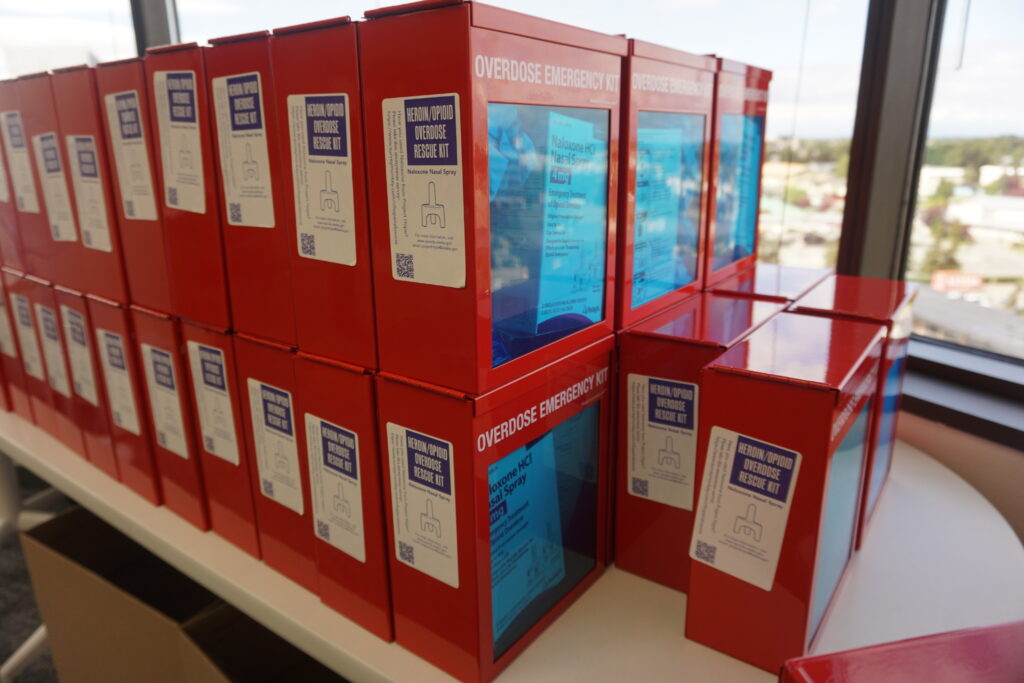Boxed kits with naloxone, an overdose-reversal drug, and associated equipment are stacked on tables at the Alaska Department of Health’s Anchorage office on Aug. 9. The kits were assembled that day in preparation for distribution to school districts around the state, in accordance with legislation that is part of a state response to Alaska’s soaring numbers of drug overdoses. (Photo by Yereth Rosen/Alaska Beacon)
Alaska had a record number of drug-overdose deaths in 2023, with a total that was 44.5% higher than in 2022, the state Department of Health said in a report issued this week.
The 2023 drug-overdose toll was 357, a number determined through the department’s data on deaths and diseases, the report said.
The Alaska statistics buck a national trend of declining overdose deaths that was reported earlier this year by the U.S. Centers for Disease Control and Prevention. Of the few states with increases in overdose deaths from 2022 to 2023, Alaska had the biggest increase by far, according to the CDC.
Opioids, especially the powerful synthetic opioid fentanyl, were involved in most of the Alaska deaths, according to the new state report.
About 80% of last year’s deaths were caused by opioids, and more than two-thirds were caused by fentanyl, according to the report. A majority of the deaths, about 60%, were from a combination of drugs, the report said.
The vast majority of the Alaska overdose deaths, 88.6%, were accidental. Suicides accounted for 6.6% of the deaths, while 4.8% were in a different and undefined category.
Victims tended to be male, aged 25 to 54 and living in the state’s urban core.
Nearly two-thirds of the fatal overdoses in 2023 were in Anchorage, the state’s largest city, which is home to about four out of every 10 Alaskans.
By age, the most overdose deaths in 2023 were among Alaskans 35 to 44 years old. The age group from 25 to 34 years old had the second highest total, at 75.
Alaska’s soaring overdose death numbers have prompted a series of state government policies and programs that complement a national educational campaign.
One state response is a new requirement that schools stock response kits containing the overdose-reversal drug naloxone. That was the result of a measure the Legislature passed earlier this year, House Bill 202, that was signed into law by Gov. Mike Dunleavy on Aug. 30.
The Department of Health has also started public-awareness campaign aimed at ensuring that all Alaskans are able to spot and properly respond to overdose cases by administering reversal medicine. The campaign has a primary message: “Save a life. Carry naloxone.”
There are also nonprofit organizations started by family members of overdose victims that seek to educate the public about opioids and steer drug abusers to treatment. Those include the AK Fentanyl Response Project, the David Dylan Foundation and the Christopher Walden House of Hope.
In a statement released by the Department of Health, Alaska’s chief medical officer said reducing overdoses will require cooperation among many parties.
“The burden of overdose fatalities will not be solved by one agency, organization, or department,” Dr. Robert Lawrence said in the statement. “Our response is weaving together the work done by so many, along five cords of intervention: interdiction, prevention, harm reduction, treatment, and recovery. Only with strong collaboration will we be able to pull people to freedom and turn the tide on this epidemic.”
GET THE MORNING HEADLINES.

